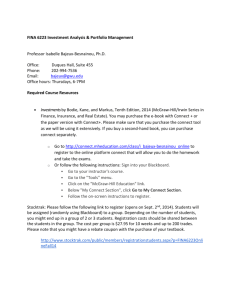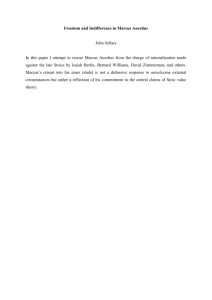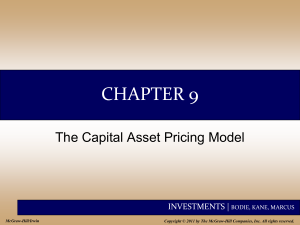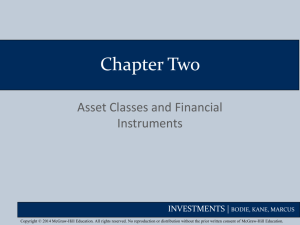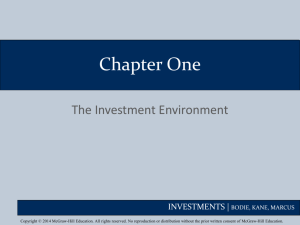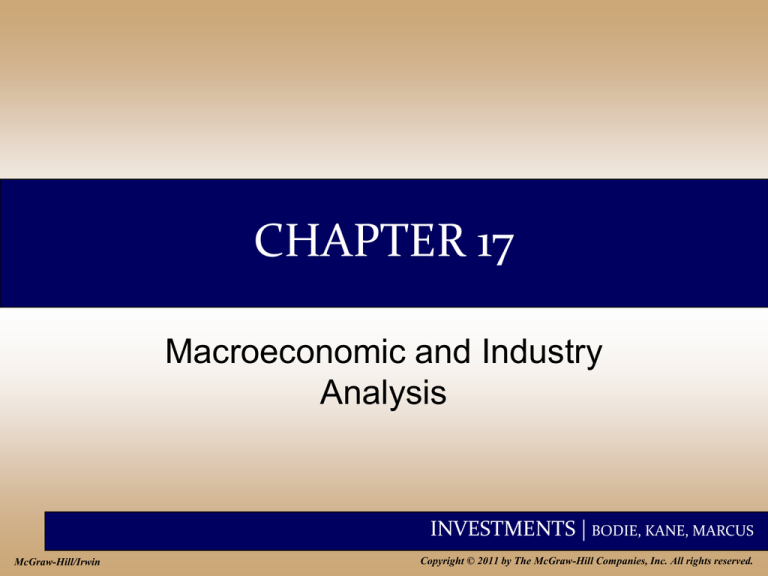
CHAPTER 17
Macroeconomic and Industry
Analysis
INVESTMENTS | BODIE, KANE, MARCUS
McGraw-Hill/Irwin
Copyright © 2011 by The McGraw-Hill Companies, Inc. All rights reserved.
17-2
Fundamental Analysis
• A firm’s value comes from its
earnings prospects, which are
determined by:
– The global economic environment
– Economic factors affecting the
firm’s industry
– The position of the firm within its
industry
INVESTMENTS | BODIE, KANE, MARCUS
17-3
The Global Economy
• Stock markets around the world
responded in unison to the financial
crisis of 2008.
• Performance in countries and regions
can be highly variable.
• It is harder for businesses to succeed in
a contracting economy than in an
expanding one.
INVESTMENTS | BODIE, KANE, MARCUS
17-4
The Global Economy
• Political risk:
– The global environment may
present much greater risks than
normally found in U.S.-based
investments.
• Exchange rate risk:
– Changes the prices of imports and
exports.
INVESTMENTS | BODIE, KANE, MARCUS
17-5
Table 17.1 Economic Performance
INVESTMENTS | BODIE, KANE, MARCUS
17-6
The Domestic Macroeconomy
• Stock prices rise with earnings.
• P/E ratios are normally in the range of 1225.
• The first step in forecasting the
performance of the broad market is to
assess the status of the economy as a
whole.
INVESTMENTS | BODIE, KANE, MARCUS
17-7
Figure 17.2 S&P 500 Index versus Earnings
Per Share
INVESTMENTS | BODIE, KANE, MARCUS
17-8
The Domestic Macroeconomy:
Key Variables
•
•
•
•
•
•
Gross domestic product
Unemployment rates
Inflation
Interest rates
Budget deficit
Consumer sentiment
INVESTMENTS | BODIE, KANE, MARCUS
17-9
Demand and Supply Shocks
• Demand shock - an
event that affects
demand for goods
and services in the
economy
• Supply shock - an
event that influences
production capacity or
production costs
INVESTMENTS | BODIE, KANE, MARCUS
17-10
Demand-side Policy
• Fiscal policy – the government’s spending
and taxing actions
• Monetary policy – manipulation of the
money supply
INVESTMENTS | BODIE, KANE, MARCUS
17-11
Fiscal Policy
• Most direct way to stimulate or slow
the economy
• Formulation of fiscal policy is often a
slow, cumbersome political process
INVESTMENTS | BODIE, KANE, MARCUS
17-12
Fiscal Policy
• To summarize the net effect of fiscal
policy, look at the budget surplus or
deficit.
• Deficit stimulates the economy
because:
– it increases the demand for goods
(via spending) by more than it
reduces the demand for goods (via
taxes)
INVESTMENTS | BODIE, KANE, MARCUS
17-13
Monetary Policy
• Manipulation of the money supply to
influence economic activity.
• Increasing the money supply lowers
interest rates and stimulates the
economy.
• Less immediate effect than fiscal policy
• Tools of monetary policy include open
market operations, discount rate,
reserve requirements.
INVESTMENTS | BODIE, KANE, MARCUS
17-14
Supply-Side Policies
• Goal: To create an environment in
which workers and owners of capital
have the maximum incentive and
ability to produce and develop goods.
• Supply-siders focus on how tax policy
can be used to improve incentives to
work and invest.
INVESTMENTS | BODIE, KANE, MARCUS
17-15
Business Cycles
• The transition points across cycles are
called peaks and troughs.
– A peak is the transition from the end of
an expansion to the start of a
contraction.
– A trough occurs at the bottom of a
recession just as the economy enters a
recovery.
INVESTMENTS | BODIE, KANE, MARCUS
17-16
The Business Cycle
Cyclical Industries
Defensive Industries
• Above-average sensitivity
to the state of the
economy.
• Examples include
producers of consumer
durables (e.g. autos) and
capital goods (i.e. goods
used by other firms to
produce their own
products.)
• High betas
• Little sensitivity to the
business cycle
• Examples include food
producers and
processors,
pharmaceutical firms, and
public utilities
• Low betas
INVESTMENTS | BODIE, KANE, MARCUS
17-17
Economic Indicators
• Leading indicators tend to rise and fall
in advance of the economy.
• Coincident indicators move with the
market.
• Lagging indicators change subsequent
to market movements.
INVESTMENTS | BODIE, KANE, MARCUS
17-18
Figure 17.4 Indexes of Leading,
Coincident, and Lagging Indicators
INVESTMENTS | BODIE, KANE, MARCUS
17-19
Table 17.4 Useful Economic
Indicators
INVESTMENTS | BODIE, KANE, MARCUS
17-20
Economic Calendar
• Many sources, such as The Wall Street
Journal and Yahoo! Finance, publish the
public announcement dates of various
economic statistics.
INVESTMENTS | BODIE, KANE, MARCUS
17-21
Figure 17.5 Economic Calendar at
Yahoo!
INVESTMENTS | BODIE, KANE, MARCUS
17-22
Industry Analysis
• It is unusual for a firm in a troubled
industry to perform well.
• Economic performance can vary
widely across industries.
INVESTMENTS | BODIE, KANE, MARCUS
17-23
Figure 17.6 Return on Equity, 2009
INVESTMENTS | BODIE, KANE, MARCUS
17-24
Figure 17.7 Industry Stock Price
Performance, 2009
INVESTMENTS | BODIE, KANE, MARCUS
17-25
Defining an Industry
• North American Industry
Classification System, or NAICS
codes
• Firms with the same four-digit NAICS
codes are commonly taken to be in
the same industry.
INVESTMENTS | BODIE, KANE, MARCUS
17-26
Table 17.5 Examples of NAICS Industry Codes
INVESTMENTS | BODIE, KANE, MARCUS
17-27
Sensitivity to the Business Cycle
• Three factors
determine
how sensitive
a firm’s
earnings are
to the
business
cycle.
1. Sensitivity of sales:
• Necessities vs.
discretionary goods
• Items that are not
sensitive to income
levels (such as tobacco
and movies) vs. items
that are, (such as
machine tools, steel,
autos)
INVESTMENTS | BODIE, KANE, MARCUS
17-28
Figure 17.9 Industry Cyclicality
INVESTMENTS | BODIE, KANE, MARCUS
17-29
Sensitivity to the Business Cycle
2. Operating
leverage :
the split
between
fixed and
variable
costs
•
•
Firms with low operating
leverage (less fixed assets)
are less sensitive to
business conditions.
Firms with high operating
leverage (more fixed
assets) are more sensitive
to the business cycle.
INVESTMENTS | BODIE, KANE, MARCUS
17-30
Table 17.6 Operating Leverage of Firms A and B
Throughout the Business Cycle
INVESTMENTS | BODIE, KANE, MARCUS
17-31
Sensitivity to the Business Cycle
3. Financial
leverage:
the use of
borrowing
• Interest is a fixed cost
that increases the
sensitivity of profits to
the business cycle.
INVESTMENTS | BODIE, KANE, MARCUS
17-32
Figure 17.10 A Stylized Depiction of the
Business Cycle
INVESTMENTS | BODIE, KANE, MARCUS
17-33
Sector Rotation
• Portfolio is shifted into industries or
sectors that should outperform,
according to the stage of the business
cycle.
• Peaks – natural resource extraction
firms
• Contraction – defensive industries
such as pharmaceuticals and food
INVESTMENTS | BODIE, KANE, MARCUS
17-34
Sector Rotation
• Trough – capital goods industries
• Expansion – cyclical industries such as
consumer durables
INVESTMENTS | BODIE, KANE, MARCUS
17-35
Figure 17.11 Sector Rotation
INVESTMENTS | BODIE, KANE, MARCUS
17-36
Industry Life Cycles
Stage
• Start-up
• Consolidation
• Maturity
• Relative Decline
Sales Growth
• Rapid and
increasing
• Stable
• Slowing
• Minimal or
negative
INVESTMENTS | BODIE, KANE, MARCUS
17-37
Figure 17.12 The Industry Life
Cycle
INVESTMENTS | BODIE, KANE, MARCUS
17-38
Which Life Cycle Stage is Most
Attractive?
• Quote from Peter Lynch in One Up on Wall
Street:
" Many people prefer to invest in a high-growth
industry, where there’s a lot of sound and
fury. Not me. I prefer to invest in a lowgrowth industry. . . .
INVESTMENTS | BODIE, KANE, MARCUS
17-39
Which Life Cycle Stage is Most
Attractive?
…In a low-growth industry, especially one
that’s boring and upsets people [such as
funeral homes or the oil-drum retrieval
business], there’s no problem with
competition. You don’t have to protect your
flanks from potential rivals . . . and this gives
you the leeway to continue to grow.”
Peter Lynch in One Up on Wall Street
INVESTMENTS | BODIE, KANE, MARCUS
17-40
Industry Structure and Performance:
Five Determinants of Competition
1.
2.
3.
4.
5.
Threat of entry
Rivalry between existing competitors
Pressure from substitute products
Bargaining power of buyers
Bargaining power of suppliers
INVESTMENTS | BODIE, KANE, MARCUS

